London Bridge - the origin of the name.
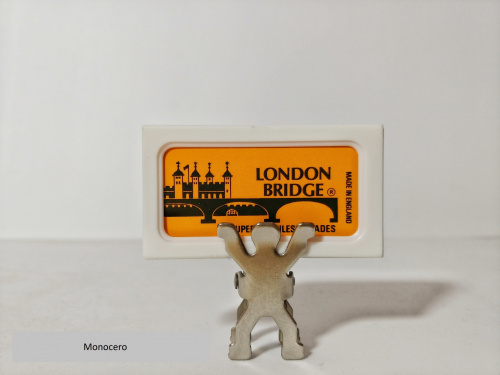
Let's start with a name that has nothing to do with the blade. London Bridge. Who and why called the razor blades that?
We will understand the history of the name of these blades after reading the book British Manufactures - Metals - by George Dood, London, Charles Knight & Co. Ludgate Street 1845 ... ”, in which the author describes the stories of John Waiss.
John Waiss was born in 1773 in today's Germany in Rostock. In 1780, he and his parents moved to London, where he was granted permanent resident status by King George IV in 1826, and was named 'Razor Maker to The King' by William IV, a title he was very proud of. William IV bestowed the title on him, and Weiss actually developed friendship with many members of the royal family.
Mr. John Weiss has spent his entire life developing surgical devices.
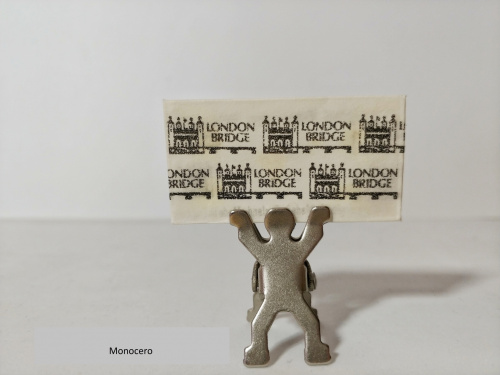
During his work with metals, he noticed that steel seemed much better when it got rusty in the ground and provided the rust was not artificially produced by the use of acids. To prove his theory, he buried some blades for almost three years. The result of the experiment fully met his expectations; the blades were covered in rust that looked like it was peeling from the inside, but not eroded, and the quality of the steel had definitely improved.
Being sure of his views, he bought, as soon as the opportunity arose, all the iron, fifteen tons, from which the elements of the London Bridge were arranged. Each piece consisted of a small, inverted pyramid, with four stripes rising from the four sides of the base. The total length from the point it entered the ground to the end of the element was approximately 16 inches and weighed approximately 8 pounds.
At that time, the state of iron from which steel was made was not yet fully understood. Some have argued that the steel or iron from which such a blade is made was of better quality because it was buried in the ground for a long time. John Waiss turned all the elements of the bridge, which had been immersed in the ground for many centuries, into steel, from which he made excellent blades.
To put a stop on the "i", he will only write that the term London Bridge refers to the Westminster Bridge on the Thames, between the Lambeth Bridge and the Hungerford Bridge, erected in the years 1739–1750.
Hence, the name London Bridge is intended to indicate the outstanding quality of razor blades.
Since the explanation of the name is behind us and now we are aware of its special nature, we can move on to the razor blades. The London Bridge razor blades were manufactured between 1972 and 1992 by Wilkinson Sword Inc., 100 Industrial Road, Berkeley Heights, N.J. 07922 Patent No. 307 1856.
London Bridge - testing a razor blade.
Before testing this razor, I tried not to suggest opinions on the Internet.
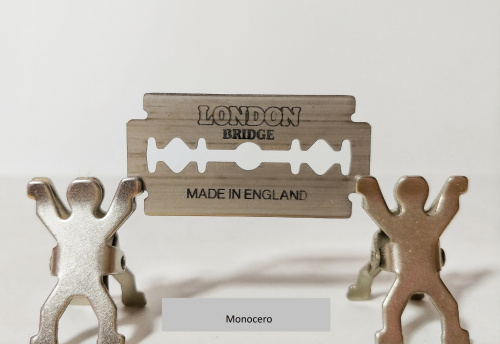
The first use of the London Bridge razor blade took place in the Father ASD2S razor, which was designed to cut a 3-day-old stubble covered with SBSS brush foam from Tabac stick soap. The razor blade turned out to be very nice and sharp. After the first use, I was not sure if it was due to the gentleness of the razor or just this razor blade is like that. I could feel the blade on my face as I shaved, but I didn't feel my stubble cutting, I just heard it. This was the type of experience I had with the Father razor blade, but it had nothing to do with comfort when used, and it gave me some red discoloration. The London Bridge razor blade passed the test with flying colors in the first use.

The second use of the London Bridge razor blade was with the Muhle R41 razor, which I shaved my head. The skin on the head is not as delicate as on the face, hence the impression that I was using a razor for the first time. A very comfortable and effective shave.
The third London Bridge razor shave was done with the RazoRock Mamba 70, which was shaved with a two-day stubble covered in Tabac stick soap foam. The entire shave was very comfortable and effective, and I did not notice any reduction in cut quality.
I used the London Bridge razor for my fourth shave in a Merkur Progress razor with London Bridge. The head was shaved. This time, while the beginning was correct, I had to finish the shave with a few corrections. It wasn't so much the clipper that hung on the hair being cut, but the transitions had to be corrected to keep it smooth. Still, I did not notice any irritations.
Thus, I consider the London Bridge razor blades to be, from my point of view, one of the best razor blades I have ever come into contact with. I am considering the quality and comfort of shaving, not its long-distance shaving. I think if you only shaved the facial hair and not the head, 4 shaves would be completely comfortable and effective.
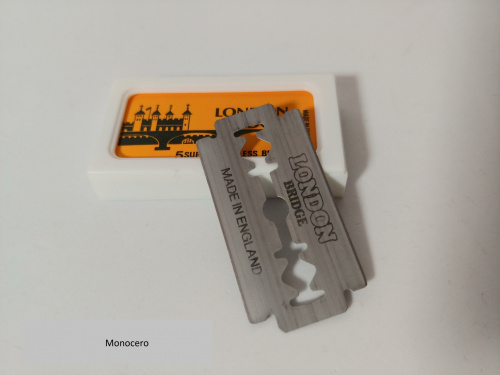
What was most striking was the lack of showing a gradual decrease in sharpness of the blade. They just stopped shaving properly and that's it.
Encouraged by the results of my test, I weighed the razor blades.
How many razor blades are there in a London Bridge razor?
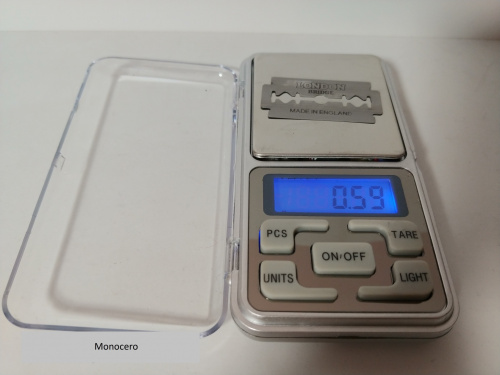
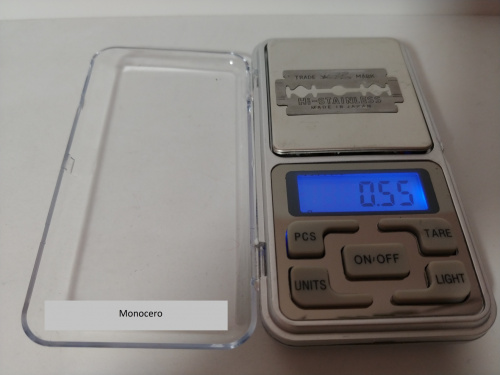
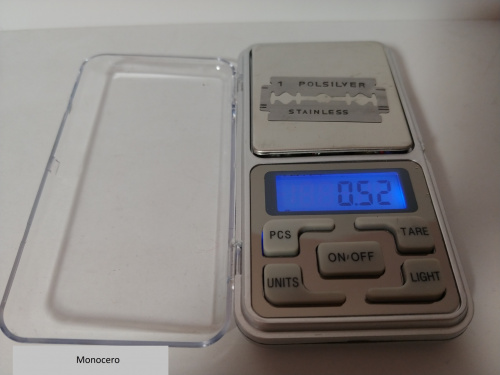
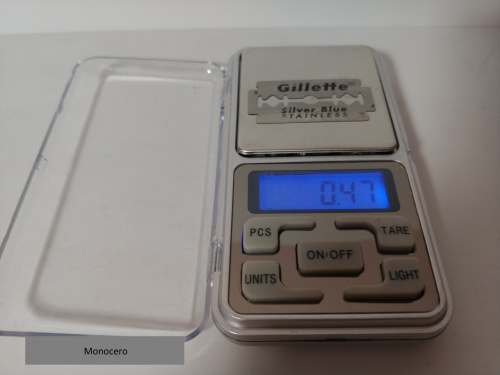
As you can see, the London Bridge razor is one of the heaviest blades, so it should be the thickest. Thus, probably the secret of effectiveness and comfort lies in the method of sharpening.
So let's see how this razor blade was sharpened. Here I used borrowed photos of my colleagues @maczeta and @zennhorst
London Bridge - razor sharpening
London Bridge - two bevel, this method of sharpening at the knives makes the KT more durable and requires less sharpening. Hence, the first conclusion can be drawn that such a KT contributes to greater durability of the razor blade.
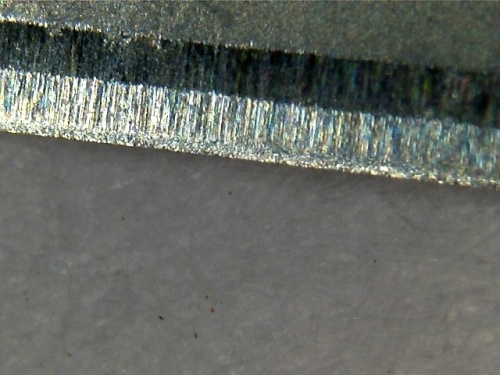
Personna 74 two bevel
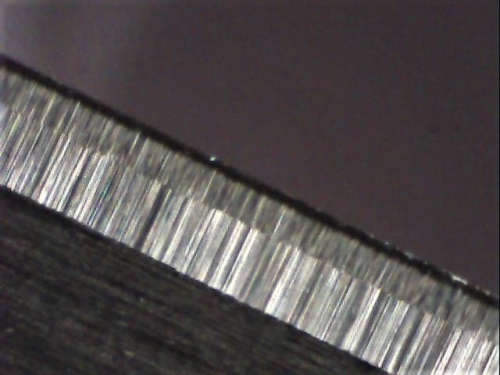
Astra green one bevel

We can see in the photos above that the vintage razor blades were sharpened differently, as if they were double-sharpened, which was supposed to affect their sharpness. Currently produced razor blades are not made like that anymore. We can speculate that this is a cut in production costs, or it was simply the replacement of production machinery.
Summing up, the London Bridge razor blades have become my # 1 for now.

Let's start with a name that has nothing to do with the blade. London Bridge. Who and why called the razor blades that?
We will understand the history of the name of these blades after reading the book British Manufactures - Metals - by George Dood, London, Charles Knight & Co. Ludgate Street 1845 ... ”, in which the author describes the stories of John Waiss.
John Waiss was born in 1773 in today's Germany in Rostock. In 1780, he and his parents moved to London, where he was granted permanent resident status by King George IV in 1826, and was named 'Razor Maker to The King' by William IV, a title he was very proud of. William IV bestowed the title on him, and Weiss actually developed friendship with many members of the royal family.
Mr. John Weiss has spent his entire life developing surgical devices.

During his work with metals, he noticed that steel seemed much better when it got rusty in the ground and provided the rust was not artificially produced by the use of acids. To prove his theory, he buried some blades for almost three years. The result of the experiment fully met his expectations; the blades were covered in rust that looked like it was peeling from the inside, but not eroded, and the quality of the steel had definitely improved.
Being sure of his views, he bought, as soon as the opportunity arose, all the iron, fifteen tons, from which the elements of the London Bridge were arranged. Each piece consisted of a small, inverted pyramid, with four stripes rising from the four sides of the base. The total length from the point it entered the ground to the end of the element was approximately 16 inches and weighed approximately 8 pounds.
At that time, the state of iron from which steel was made was not yet fully understood. Some have argued that the steel or iron from which such a blade is made was of better quality because it was buried in the ground for a long time. John Waiss turned all the elements of the bridge, which had been immersed in the ground for many centuries, into steel, from which he made excellent blades.
To put a stop on the "i", he will only write that the term London Bridge refers to the Westminster Bridge on the Thames, between the Lambeth Bridge and the Hungerford Bridge, erected in the years 1739–1750.
Hence, the name London Bridge is intended to indicate the outstanding quality of razor blades.
Since the explanation of the name is behind us and now we are aware of its special nature, we can move on to the razor blades. The London Bridge razor blades were manufactured between 1972 and 1992 by Wilkinson Sword Inc., 100 Industrial Road, Berkeley Heights, N.J. 07922 Patent No. 307 1856.
London Bridge - testing a razor blade.
Before testing this razor, I tried not to suggest opinions on the Internet.

The first use of the London Bridge razor blade took place in the Father ASD2S razor, which was designed to cut a 3-day-old stubble covered with SBSS brush foam from Tabac stick soap. The razor blade turned out to be very nice and sharp. After the first use, I was not sure if it was due to the gentleness of the razor or just this razor blade is like that. I could feel the blade on my face as I shaved, but I didn't feel my stubble cutting, I just heard it. This was the type of experience I had with the Father razor blade, but it had nothing to do with comfort when used, and it gave me some red discoloration. The London Bridge razor blade passed the test with flying colors in the first use.

The second use of the London Bridge razor blade was with the Muhle R41 razor, which I shaved my head. The skin on the head is not as delicate as on the face, hence the impression that I was using a razor for the first time. A very comfortable and effective shave.
The third London Bridge razor shave was done with the RazoRock Mamba 70, which was shaved with a two-day stubble covered in Tabac stick soap foam. The entire shave was very comfortable and effective, and I did not notice any reduction in cut quality.
I used the London Bridge razor for my fourth shave in a Merkur Progress razor with London Bridge. The head was shaved. This time, while the beginning was correct, I had to finish the shave with a few corrections. It wasn't so much the clipper that hung on the hair being cut, but the transitions had to be corrected to keep it smooth. Still, I did not notice any irritations.
Thus, I consider the London Bridge razor blades to be, from my point of view, one of the best razor blades I have ever come into contact with. I am considering the quality and comfort of shaving, not its long-distance shaving. I think if you only shaved the facial hair and not the head, 4 shaves would be completely comfortable and effective.

What was most striking was the lack of showing a gradual decrease in sharpness of the blade. They just stopped shaving properly and that's it.
Encouraged by the results of my test, I weighed the razor blades.
How many razor blades are there in a London Bridge razor?




As you can see, the London Bridge razor is one of the heaviest blades, so it should be the thickest. Thus, probably the secret of effectiveness and comfort lies in the method of sharpening.
So let's see how this razor blade was sharpened. Here I used borrowed photos of my colleagues @maczeta and @zennhorst
London Bridge - razor sharpening
London Bridge - two bevel, this method of sharpening at the knives makes the KT more durable and requires less sharpening. Hence, the first conclusion can be drawn that such a KT contributes to greater durability of the razor blade.

Personna 74 two bevel

Astra green one bevel

We can see in the photos above that the vintage razor blades were sharpened differently, as if they were double-sharpened, which was supposed to affect their sharpness. Currently produced razor blades are not made like that anymore. We can speculate that this is a cut in production costs, or it was simply the replacement of production machinery.
Summing up, the London Bridge razor blades have become my # 1 for now.